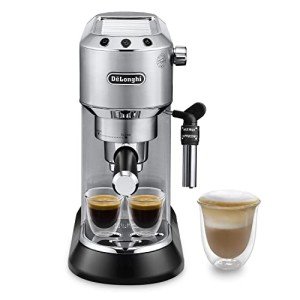The Ultimate Guide to Cappuccino Machines: Brewing the Perfect Cup
Cappuccinos are a cherished coffee drink that integrates the abundant flavors of espresso with steamed milk and milk foam. For many, absolutely nothing tastes much better than a homemade cappuccino crafted with precision. However, reproducing the ability of a barista in your home needs the best equipment. This is where cappuccino machines enter into play. This article looks into the different types of cappuccino machines, how they work, and suggestions for selecting the very best one for your needs.
What is a Cappuccino Machine?
A cappuccino machine is a customized developing device created to make cappuccinos and other espresso-based beverages. These machines generally feature a built-in espresso maker, a milk frother, and numerous controls for adjusting temperature and pressure. Cappuccino machines can be manual, semi-automatic, or fully automatic, providing numerous levels of user control depending on the complexity of the machine.
Types of Cappuccino Machines
1. Manual Espresso Machines
- Description: These machines need users to operate most functions by hand, including grinding coffee beans, tamping the premises, pulling the espresso shot, and frothing the milk.
- Pros:
- Offers complete control over the brewing process.
- Can produce high-quality, café-like espresso.
- Cons:
- Steeper learning curve.
- Requires more effort and time.
2. Semi-Automatic Espresso Machines
- Description: Semi-automatic machines automate some procedures, such as water pressure. Users still require to grind coffee and froth milk by hand.
- Pros:
- Balanced control and convenience.
- Enables room for experimentation.
- Cons:
- Still needs practical skills.
- Can be intricate for novices.
3. Completely Automatic Espresso Machines
- Description: These machines automate the entire brewing process, from grinding to frothing. Users just choose the preferred beverage.
- Pros:
- Extremely convenient and easy to use.
- Constant results with little effort.
- Cons:
- More expensive.
- Limited control over the brewing procedure.
4. Super Automatic Espresso Machines
- Description: Similar to fully automatic machines, but these models include features like an integrated milk frother and grinder. Professional Espresso Machines prepare drinks with simply the touch of a button.
- Pros:
- Ultimate benefit; makes various beverages rapidly.
- Built-in cleansing and upkeep features.
- Cons:
- High preliminary expense.
- Less hands-on experience with coffee making.
Key Features to Consider
When selecting a cappuccino machine, numerous functions can considerably affect efficiency and user experience. Here are some important elements to assess:
1. Construct Quality
- Materials utilized (stainless steel, plastic)
- Durability and durability
2. Capacity
- Water tank size
- Bean hopper capability
3. Frothing Capability
- Kind of frothing wand (manual, automatic)
- Steam pressure and temperature level control
4. Reduce of Use
- Intuitive controls
- Cleaning and maintenance requirements
5. Price
- Range from budget to high-end models
- Consider guarantees and consumer support choices
6. Brand name Reputation
- User reviews and professional viewpoints
- Accessibility of replacement parts
The Brewing Process
To brew the ideal cappuccino at home, follow this process, despite the machine type:
- Prepare the Espresso: Use freshly ground coffee beans and pull a double shot (roughly 2 ounces) of espresso.
- Froth the Milk: Steam fresh milk to a temperature about 150 ° F( 65 ° C)utilizing the steam wand or automatic frother.
- Integrate: Pour the steamed milk over the espresso, followed by a layer of milk foam (equal parts espresso and steamed milk, with about 1 cm of foam).
For a visual representation, here's a basic table comparing the characteristics of the cappuccino machine types:
| Machine Type | Control Level | Relieve of Use | Price Range | Suitable For |
|---|---|---|---|---|
| Manual Espresso Machine | High | Difficult | Low to Medium | Coffee enthusiasts, perfectionists |
| Semi-Automatic Machine | Medium | Moderate | Medium | Home baristas, hobbyists |
| Completely Automatic Machine | Low | Easy | Medium to High | Casual drinkers |
| Super Automatic Machine | Extremely Low | Very Easy | High | Hectic specialists |
Often Asked Questions (FAQs)
What is the best milk to use for coffees?
Entire milk is commonly chosen for frothing due to its fat content, which creates a velvety texture. However, options like almond milk, oat milk, or soy milk can be used, though they may require different frothing techniques.
How do I tidy my cappuccino machine?
The majority of machines come with particular cleaning guidelines. Generally, you ought to regularly clean the group head, steam wand, and drip tray. For automatic machines, lots of designs feature self-cleaning cycles.
Can I use pre-ground coffee rather of whole beans?
Yes, you can use pre-ground coffee. Nevertheless, freshly ground coffee normally produces a more delicious espresso due to the oils in the beans being protected.
How much should I invest in a cappuccino machine?
The rate varies significantly based on features, brand, and quality. A fundamental, excellent quality machine may begin around ₤ 200, while high-end very automatic machines can go beyond ₤ 2,000.
How often should I change my cappuccino machine?
With appropriate maintenance, a high-quality cappuccino machine can last for several years. However, you might consider upgrading if you find your machine no longer meets your brewing needs or experiences performance problems.
Cappuccino machines are powerful allies in providing the perfect brew in the house. Whether you prefer manual interaction with your coffee or prefer the convenience of fully automated machines, understanding the various types and their features will assist you in making the ideal choice. By purchasing the ideal machine for your requirements and utilizing the right methods, anyone can enjoy a barista-quality cappuccino from the comfort of their own cooking area. With a bit of patience and creativity, the art of cappuccino brewing can become a delightful routine, developing not simply coffee however minutes of happiness.

